Abstract
The inhibition of the membrane-bound enzyme cytochrome c oxidase by aliphatic n-alcohols and other neutral organic compounds was studied as a model for anaesthetic action and drug toxicity. The n-alcohols (C1 to C14) displayed a variation in inhibition constant of over 500,000-fold. The inhibition constants correlated well with the number of carbon atoms in the n-alcohols and also their n-octanol/water partition coefficients. General anaesthetic potency is known to be similarly well correlated with octanol/water partition coefficients. The free-energy change for transferring a methylene group of the n-alcohol to the more hydrophobic environment bound to the enzyme is similar to that for transferring a methylene group from water to pure alcohol. These results are consistent with the n-alcohols inhibiting by binding to an octanol-like environment on the enzyme or the protein/phospholipid interface. Neither negatively charged carboxylates nor positively charged amine analogues were observed to cause any inhibition, indicating that this postulated binding site may be uncharged. Inhibition of cytochrome c oxidase by n-alcohols was also demonstrated in both bovine heart and rat liver sonicated submitochondrial fragments.
Full text
PDF
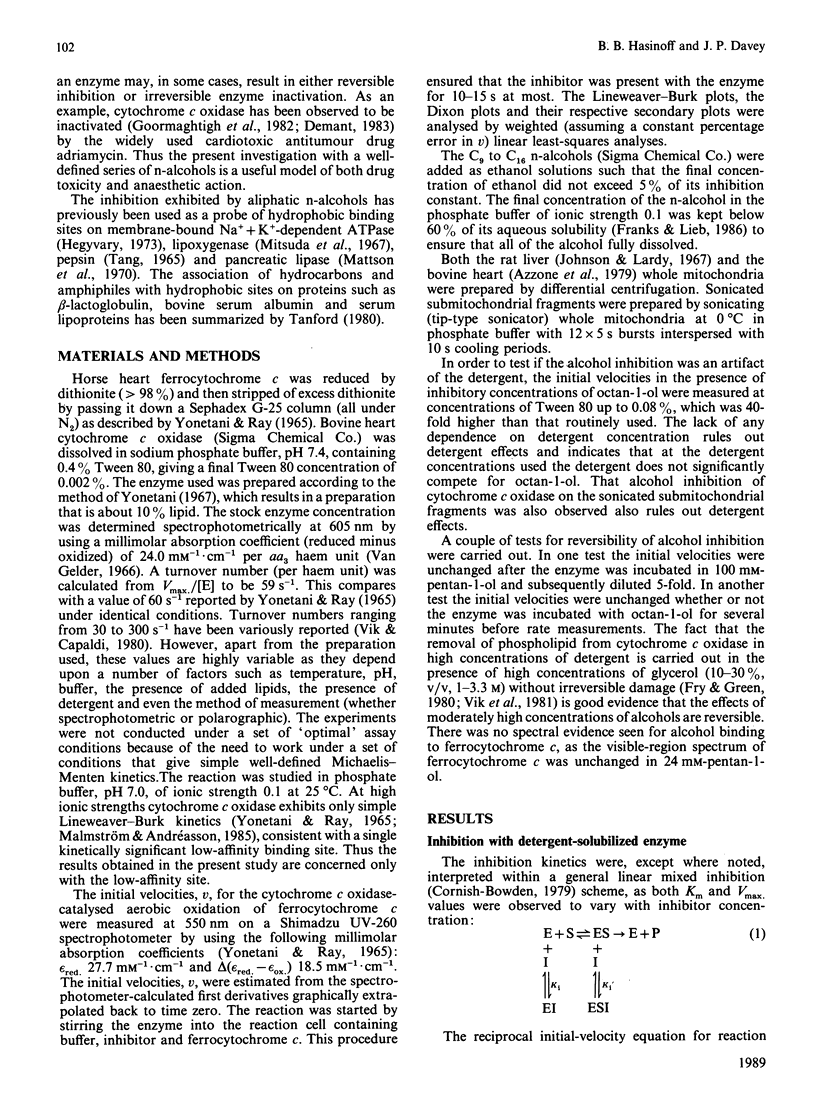
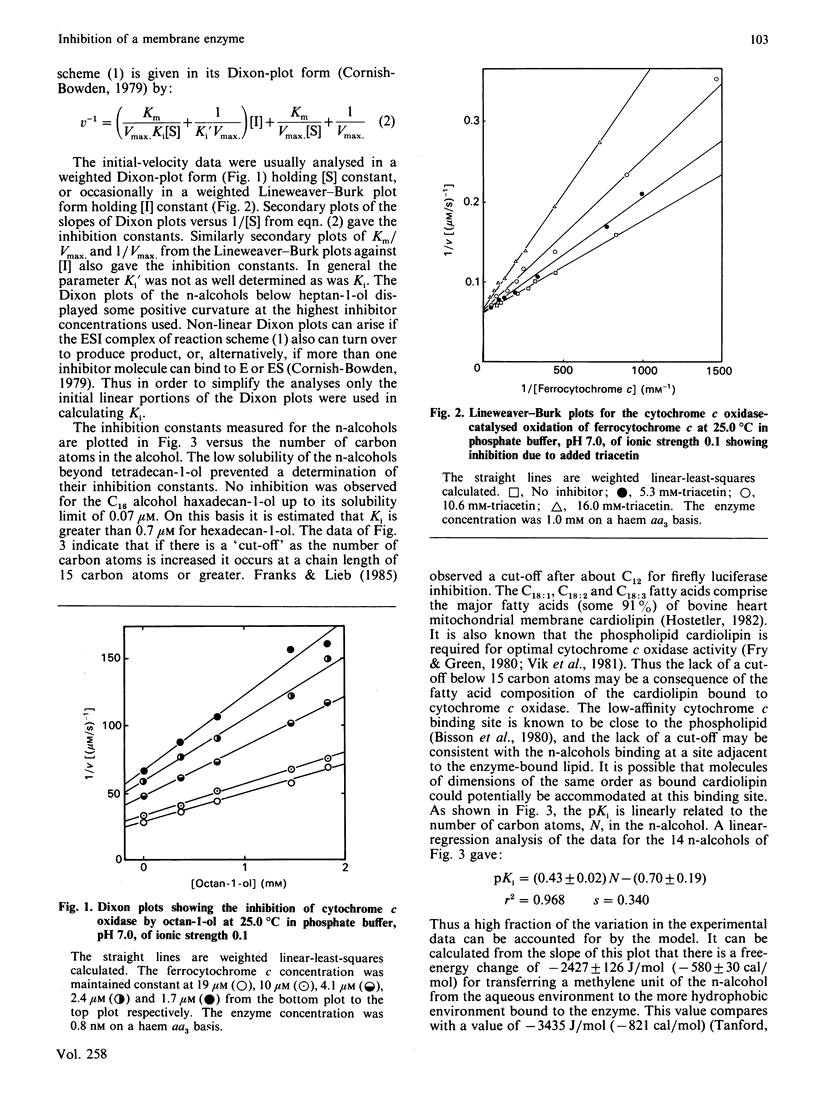
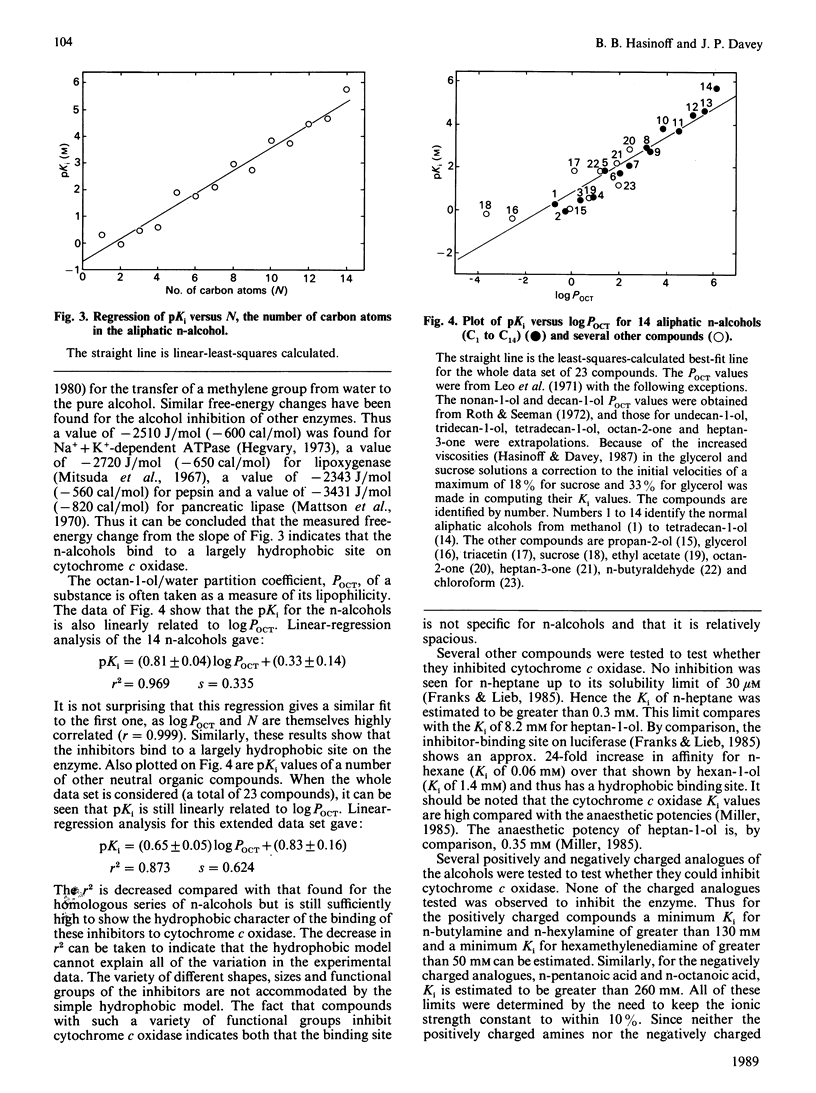
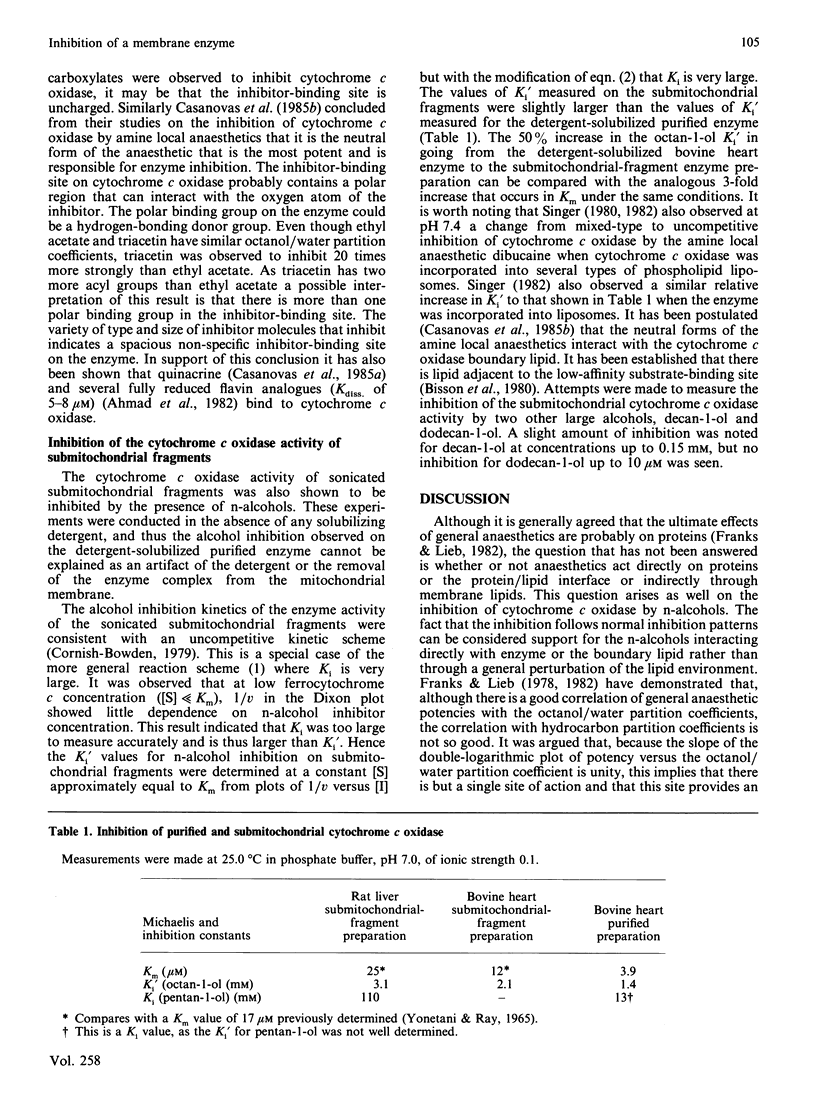
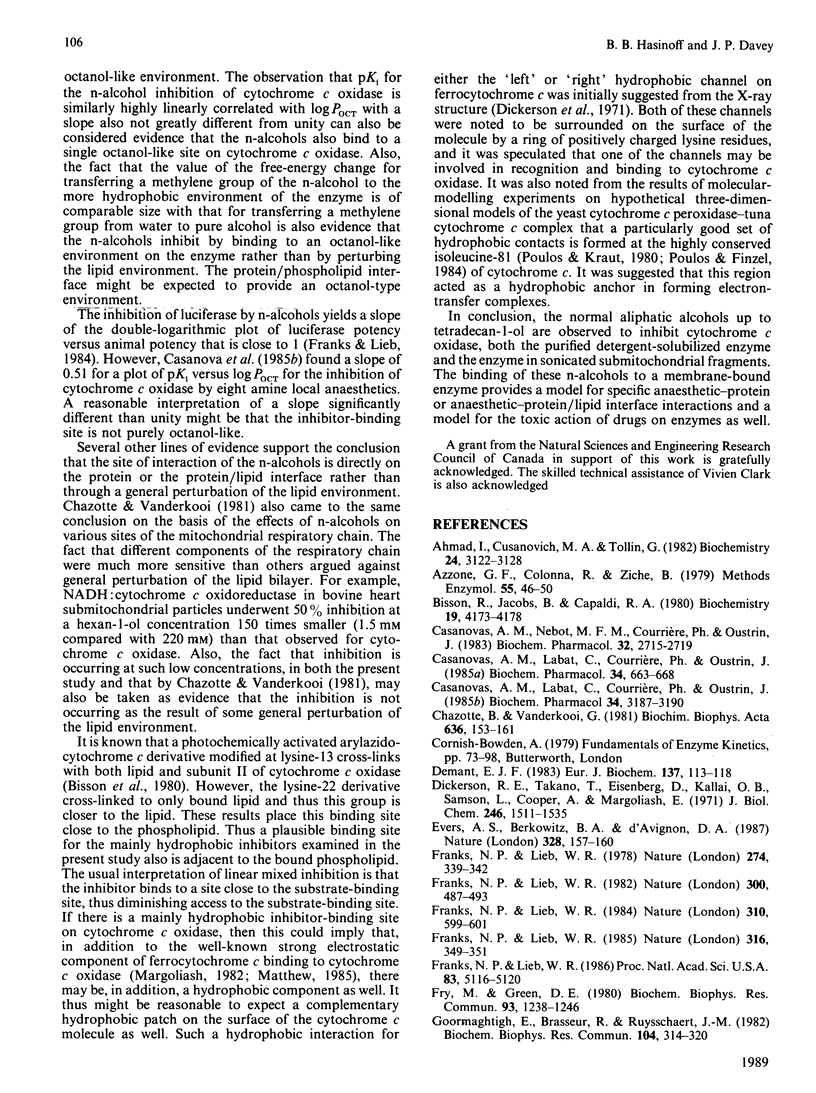
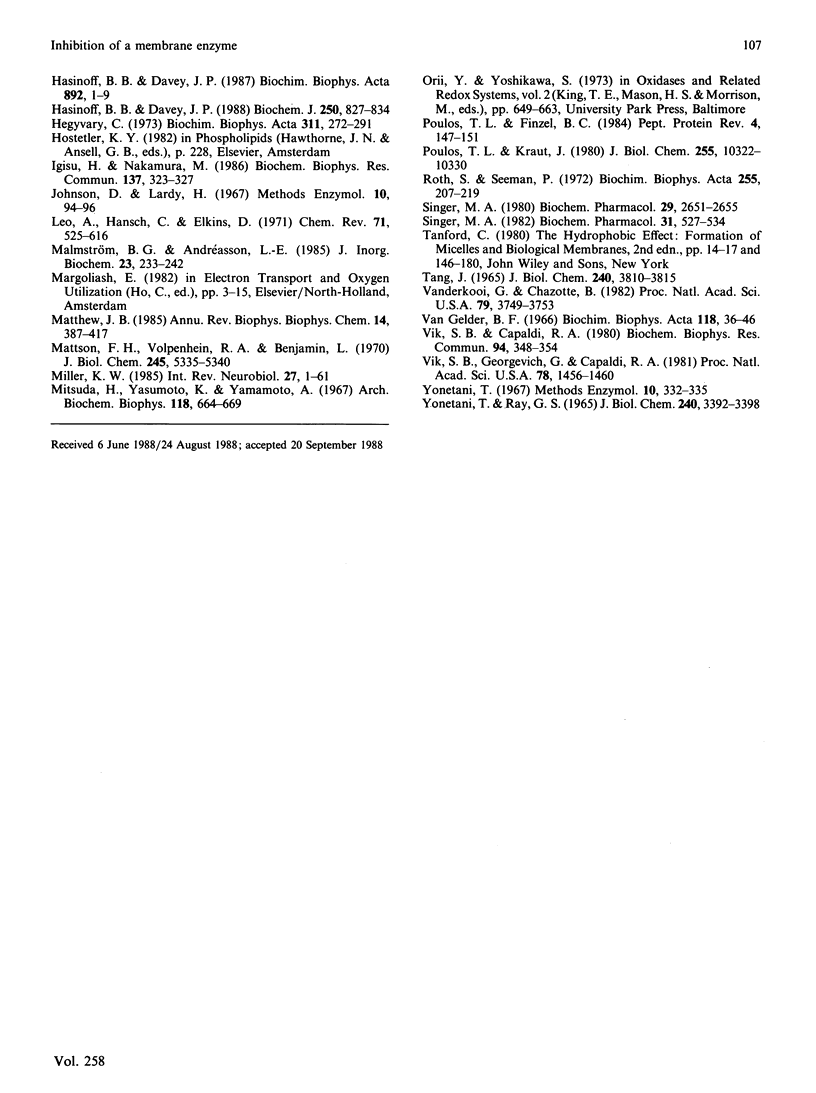
Selected References
These references are in PubMed. This may not be the complete list of references from this article.
- Ahmad I., Cusanovich M. A., Tollin G. Laser flash photolysis studies of electron transfer between semiquinone and fully reduced free flavins and the cytochrome c-cytochrome oxidase complex. Biochemistry. 1982 Jun 22;21(13):3122–3128. doi: 10.1021/bi00256a014. [DOI] [PubMed] [Google Scholar]
- Azzone G. F., Colonna R., Ziche B. Preparation of bovine heart mitochondria in high yield. Methods Enzymol. 1979;55:46–50. doi: 10.1016/0076-6879(79)55007-1. [DOI] [PubMed] [Google Scholar]
- Bisson R., Jacobs B., Capaldi R. A. Binding of arylazidocytochrome c derivatives to beef heart cytochrome c oxidase: cross-linking in the high- and low-affinity binding sites. Biochemistry. 1980 Sep 2;19(18):4173–4178. doi: 10.1021/bi00559a006. [DOI] [PubMed] [Google Scholar]
- Casanovas A. M., Labat C., Courriere P., Oustrin J. Interaction of local anaesthetics with cytochrome oxidase studied with fluorescence quenching. Biochem Pharmacol. 1985 Mar 1;34(5):663–668. doi: 10.1016/0006-2952(85)90261-8. [DOI] [PubMed] [Google Scholar]
- Casanovas A. M., Labat C., Courriere P., Oustrin J. Model for action of local anaesthetics with cytochrome oxidase. Biochem Pharmacol. 1985 Sep 1;34(17):3187–3190. doi: 10.1016/0006-2952(85)90168-6. [DOI] [PubMed] [Google Scholar]
- Casanovas A. M., Malmary Nebot M. F., Courrière P., Oustrin J. Inhibition of cytochrome oxidase activity by local anaesthetics. Biochem Pharmacol. 1983 Sep 15;32(18):2715–2719. doi: 10.1016/0006-2952(83)90081-3. [DOI] [PubMed] [Google Scholar]
- Chazotte B., Vanderkooi G. Multiple sites of inhibition of mitochondrial electron transport by local anesthetics. Biochim Biophys Acta. 1981 Jul;636(2):153–161. doi: 10.1016/0005-2728(81)90088-8. [DOI] [PubMed] [Google Scholar]
- Demant E. J. NADH oxidation in submitochondrial particles protects respiratory chain activity against damage by adriamycin-Fe3+. Eur J Biochem. 1983 Dec 1;137(1-2):113–118. doi: 10.1111/j.1432-1033.1983.tb07803.x. [DOI] [PubMed] [Google Scholar]
- Dickerson R. E., Takano T., Eisenberg D., Kallai O. B., Samson L., Cooper A., Margoliash E. Ferricytochrome c. I. General features of the horse and bonito proteins at 2.8 A resolution. J Biol Chem. 1971 Mar 10;246(5):1511–1535. [PubMed] [Google Scholar]
- Evers A. S., Berkowitz B. A., d'Avignon D. A. Correlation between the anaesthetic effect of halothane and saturable binding in brain. Nature. 1987 Jul 9;328(6126):157–160. doi: 10.1038/328157a0. [DOI] [PubMed] [Google Scholar]
- Franks N. P., Lieb W. R. Do general anaesthetics act by competitive binding to specific receptors? Nature. 1984 Aug 16;310(5978):599–601. doi: 10.1038/310599a0. [DOI] [PubMed] [Google Scholar]
- Franks N. P., Lieb W. R. Mapping of general anaesthetic target sites provides a molecular basis for cutoff effects. Nature. 1985 Jul 25;316(6026):349–351. doi: 10.1038/316349a0. [DOI] [PubMed] [Google Scholar]
- Franks N. P., Lieb W. R. Molecular mechanisms of general anaesthesia. Nature. 1982 Dec 9;300(5892):487–493. doi: 10.1038/300487a0. [DOI] [PubMed] [Google Scholar]
- Franks N. P., Lieb W. R. Partitioning of long-chain alcohols into lipid bilayers: implications for mechanisms of general anesthesia. Proc Natl Acad Sci U S A. 1986 Jul;83(14):5116–5120. doi: 10.1073/pnas.83.14.5116. [DOI] [PMC free article] [PubMed] [Google Scholar]
- Franks N. P., Lieb W. R. Where do general anaesthetics act? Nature. 1978 Jul 27;274(5669):339–342. doi: 10.1038/274339a0. [DOI] [PubMed] [Google Scholar]
- Fry M., Green D. E. Cardiolipin requirement by cytochrome oxidase and the catalytic role of phospholipid. Biochem Biophys Res Commun. 1980 Apr 29;93(4):1238–1246. doi: 10.1016/0006-291x(80)90622-1. [DOI] [PubMed] [Google Scholar]
- Goormaghtigh E., Brasseur R., Ruysschaert J. M. Adriamycin inactivates cytochrome c oxidase by exclusion of the enzyme from its cardiolipin essential environment. Biochem Biophys Res Commun. 1982 Jan 15;104(1):314–320. doi: 10.1016/0006-291x(82)91976-3. [DOI] [PubMed] [Google Scholar]
- Hasinoff B. B., Davey J. P. The iron(III)-adriamycin complex inhibits cytochrome c oxidase before its inactivation. Biochem J. 1988 Mar 15;250(3):827–834. doi: 10.1042/bj2500827. [DOI] [PMC free article] [PubMed] [Google Scholar]
- Hasinoff B. B., Davey J. P. The kinetics of the aerobic oxidation of ferrocytochrome c by cytochrome c oxidase in solvents of increased viscosity are partially diffusion controlled. Biochim Biophys Acta. 1987 Jun 9;892(1):1–9. doi: 10.1016/0005-2728(87)90241-6. [DOI] [PubMed] [Google Scholar]
- Hegyvary C. Effects of some organic solvents on the reactivity of sodium plus potassium ion-transport ATPase. Biochim Biophys Acta. 1973 Jun 22;311(2):272–291. doi: 10.1016/0005-2736(73)90274-5. [DOI] [PubMed] [Google Scholar]
- Igisu H., Nakamura M. Inhibition of cytochrome c oxidase by psychosine (galactosylsphingosine). Biochem Biophys Res Commun. 1986 May 29;137(1):323–327. doi: 10.1016/0006-291x(86)91213-1. [DOI] [PubMed] [Google Scholar]
- Matthew J. B. Electrostatic effects in proteins. Annu Rev Biophys Biophys Chem. 1985;14:387–417. doi: 10.1146/annurev.bb.14.060185.002131. [DOI] [PubMed] [Google Scholar]
- Mattson F. H., Volpenhein R. A., Benjamin L. Inhibition of lipolysis by normal alcohols. J Biol Chem. 1970 Oct 25;245(20):5335–5340. [PubMed] [Google Scholar]
- Miller K. W. The nature of the site of general anesthesia. Int Rev Neurobiol. 1985;27:1–61. doi: 10.1016/s0074-7742(08)60555-3. [DOI] [PubMed] [Google Scholar]
- Mitsuda H., Yasumoto K., Yamamoto A. Inhibition of lipoxygenase by saturated monohydric alcohols through hydrophobic bondings. Arch Biochem Biophys. 1967 Mar 20;118(3):664–669. doi: 10.1016/0003-9861(67)90403-1. [DOI] [PubMed] [Google Scholar]
- Poulos T. L., Kraut J. A hypothetical model of the cytochrome c peroxidase . cytochrome c electron transfer complex. J Biol Chem. 1980 Nov 10;255(21):10322–10330. [PubMed] [Google Scholar]
- Roth S., Seeman P. The membrane concentrations of neutral and positive anesthetics (alcohols, chlorpromazine, morphine) fit the Meyer-Overton rule of anesthesia; negative narcotics do not. Biochim Biophys Acta. 1972 Jan 17;255(1):207–219. doi: 10.1016/0005-2736(72)90023-5. [DOI] [PubMed] [Google Scholar]
- Singer M. A. Interaction of drugs with a model membrane protein. Effect of dibucaine on cytochrome oxidase proteoliposomes. Biochem Pharmacol. 1982 Feb 15;31(4):527–534. doi: 10.1016/0006-2952(82)90155-1. [DOI] [PubMed] [Google Scholar]
- Singer M. A. Interaction of drugs with a model membrane protein. Effects of four local anesthetics on cytochrome oxidase activity. Biochem Pharmacol. 1980 Oct 1;29(19):2651–2655. doi: 10.1016/0006-2952(80)90081-7. [DOI] [PubMed] [Google Scholar]
- Tang J. Competitive inhibition of pepsin by aliphatic alcohols. J Biol Chem. 1965 Oct;240(10):3810–3815. [PubMed] [Google Scholar]
- Vanderkooi G., Chazotte B. Cytochrome c oxidase inhibition by anesthetics: thermodynamic analysis. Proc Natl Acad Sci U S A. 1982 Jun;79(12):3749–3753. doi: 10.1073/pnas.79.12.3749. [DOI] [PMC free article] [PubMed] [Google Scholar]
- Vik S. B., Capaldi R. A. Conditions for optimal electron transfer activity of cytochrome c oxidase isolated from beef heart mitochondria. Biochem Biophys Res Commun. 1980 May 14;94(1):348–354. doi: 10.1016/s0006-291x(80)80227-0. [DOI] [PubMed] [Google Scholar]
- Vik S. B., Georgevich G., Capaldi R. A. Diphosphatidylglycerol is required for optimal activity of beef heart cytochrome c oxidase. Proc Natl Acad Sci U S A. 1981 Mar;78(3):1456–1460. doi: 10.1073/pnas.78.3.1456. [DOI] [PMC free article] [PubMed] [Google Scholar]
- YONETANI T., RAY G. S. STUDIES ON CYTOCHROME OXIDASE. VI. KINETICS OF THE AEROBIC OXIDATION OF FERROCYTOCHROME C BY CYTOCHROME OXIDASE. J Biol Chem. 1965 Aug;240:3392–3398. [PubMed] [Google Scholar]
- van Gelder B. F. On cytochrome c oxidase. I. The extinction coefficients of cytochrome a and cytochrome a3. Biochim Biophys Acta. 1966 Apr 12;118(1):36–46. doi: 10.1016/s0926-6593(66)80142-x. [DOI] [PubMed] [Google Scholar]


